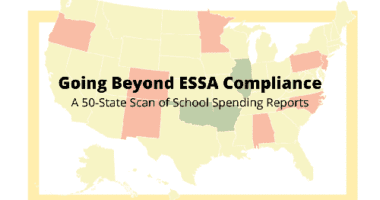Why We Need to Protect the Civil Rights Data Collection (CRDC) from Secretary DeVos’ Proposed Cuts
What happened: The Trump administration proposed several changes to the U.S. Department of Education’s biennial Civil Rights Data Collection (CRDC). Public comments are being accepted on the proposal until November 18, 2019.
What’s going away: The Department has proposed removing several critical elements from the survey, including questions about school finances, whether teachers are in their first few years on the job, and advanced coursework. The Department also plans to eliminate a series of questions about how schools are providing early childhood education.
What Ed Trust says: It’s striking that much of what the Department is proposing to eliminate are the data points most used by families and civil rights advocates to make the case for more equitable access to high-quality education for Black and Latino students. It’s a classic tactic if you want to get in the way of real change — hide the problem. If you don’t have good data that shows where schools are excluding children from high-quality educational opportunity — whether that’s in the form of early childhood, great teachers, or advanced coursework — it’s extremely hard to make the case for change.
The CRDC is one of the most actionable of the many data collections the U.S. Department of Education runs. Instead of simply saying, “Here’s a problem: Some kids aren’t graduating, and some kids don’t have great test scores.” It helps advocates to say, “Some kids are being unfairly excluded from preschool, and being taught by first-year teachers, and being kept out of advanced coursework opportunities.” Those are things that policymakers and practitioners can actually do something about.
Preschool Enrollment and Discipline
For example, 3- and 4-year-olds are being suspended from preschool across the country. That’s crazy. But what’s even worse is that Black children make up just 20% of preschool children but nearly 50% of those suspended. We know that because of the CRDC. It’s the beginning of the outrageous school to prison pipeline that disproportionately affects Black and Latino students of every age.
Because of these data points — and the tireless advocacy by civil rights groups, parents, and educators, to make sure that policymakers know about them — we have started to see a concerted effort to eliminate suspensions in preschool. If the Department’s proposal to eliminate preschool enrollment data by race/ethnicity goes into effect we won’t be able to tell this story – we won’t have the numbers we need to measure disproportionality of preschool discipline for children of color.
It’s a great example of how important it is to have data broken down by race and ethnicity. If we can’t see the problems in hard numbers, too many people want to pretend they aren’t there. But the CRDC’s data is clear and unflinching, for all to see. The Department of Education needs to keep it that way.
Novice Teachers
Research shows that teachers get better in each of their first three years of teaching. But across the country, some schools and districts are relying heavily on first-year teachers because they can’t retain their staff for all sorts of reasons: school climate and culture is bad, teachers are overworked because there are no school counselors or mental health providers to support their students, or the building is falling apart, etc. It’s incredibly important to track this information in order to advocate for policy changes and investments in the schools and districts with this particular problem. And, just like in the early childhood space, Black and Latino students are far more likely to be exposed to novice teachers — another thing we know because of the CRDC. To stop collecting this data is to say, “Let’s pretend the problem doesn’t exist.”
Advanced Coursework
At Ed Trust, we’re using CRDC data for a report that will be out later this fall that looks at the disproportionate exclusion of Black and Latino students from Advanced Placement courses state by state. It allows policymakers and advocates to understand exactly what is causing this problem in their state — whether it’s a lack of AP courses altogether at the schools that serve large numbers of Black and Latino students, or too few seats in those courses, or — most often — that Black and Latino students are being denied their fair share of those seats within schools.
So we’re clearly concerned about the Department’s proposal to eliminate a question on whether schools offer AP courses beyond math, science, and computer science. AP courses such as world language and culture are important, and if schools serving Black and Latino students aren’t offering them — or aren’t offering enough of them relative to other schools — that’s yet another opportunity gap we need to close if we’re serious about closing achievement gaps.
But just taking the course isn’t good enough – taking (and passing!) the exam at the end of AP courses is key to getting that first college credit, or testing out of an entry level class freshman year of college. If schools serving high concentrations of Black or Latino students are getting them into the course but don’t ensure they take and pass the exam, that school still have a problem. Unfortunately the Department is proposing to eliminate the only question about whether students take the exam at the end of AP courses in high school — again, letting them bury their heads sand and pretend that there’s no problem.
School Spending
Research shows that school spending matters — more money leads to better outcomes, especially if spent well and spent in schools serving students with the highest needs. And yet, we continue to under-invest in schools serving high concentrations of students of color and students living in poverty. While lots of people understand that some school districts are sorely underfunded, it’s also true that high need schools are often shortchanged within their own districts. We’re just starting to see real advocacy to improve equity in school funding within districts — it’s the cutting edge of the fight for equity in school funding.
Not surprisingly, I suppose, the single largest cut the Department is proposing is to completely eliminate the school funding portion of the survey. To be clear, the CRDC is the only data source that shows school level expenditures across the country. (Yes, my wonky friends, the Every Student Succeeds Act requires similar data to be reported by state departments of education – but for now, that data doesn’t exist yet, and even when it does, there are no rules that the data be collected in the same way from state to state, or even from district to district within a state; so it’s important that we continue to use and improve the only national data source on this topic instead of eliminating it).
Putting It All Together
The CRDC is important. It’s run out of the Department of Education’s Office for Civil Rights for a reason – it’s a data source designed to identify violations of civil rights for historically marginalized groups who are protected by law from discrimination on the basis of race, color, national origin, sex, or disability. These proposed cuts will undermine the ability of advocates — from lawyers to parents — to protect the rights of individual students and to build the movement for educational equity in our schools. We should all make sure the Administration knows that we oppose these cuts by commenting before November 18.










